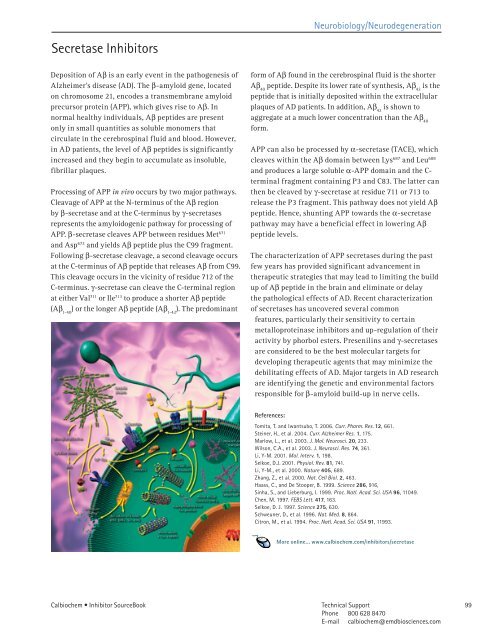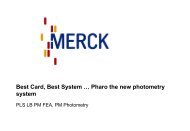Inhibitor SourceBook™ Second Edition
Inhibitor SourceBook™ Second Edition
Inhibitor SourceBook™ Second Edition
You also want an ePaper? Increase the reach of your titles
YUMPU automatically turns print PDFs into web optimized ePapers that Google loves.
Secretase <strong>Inhibitor</strong>s<br />
Deposition of Ab is an early event in the pathogenesis of<br />
Alzheimer's disease (AD). The b-amyloid gene, located<br />
on chromosome 21, encodes a transmembrane amyloid<br />
precursor protein (APP), which gives rise to Ab. In<br />
normal healthy individuals, Ab peptides are present<br />
only in small quantities as soluble monomers that<br />
circulate in the cerebrospinal fluid and blood. However,<br />
in AD patients, the level of Ab peptides is significantly<br />
increased and they begin to accumulate as insoluble,<br />
fibrillar plaques.<br />
Processing of APP in vivo occurs by two major pathways.<br />
Cleavage of APP at the N-terminus of the Ab region<br />
by b-secretase and at the C-terminus by g-secretases<br />
represents the amyloidogenic pathway for processing of<br />
APP. b-secretase cleaves APP between residues Met 671<br />
and Asp 672 and yields Ab peptide plus the C99 fragment.<br />
Following b-secretase cleavage, a second cleavage occurs<br />
at the C-terminus of Ab peptide that releases Ab from C99.<br />
This cleavage occurs in the vicinity of residue 712 of the<br />
C-terminus. g-secretase can cleave the C-terminal region<br />
at either Val 711 or Ile 713 to produce a shorter Ab peptide<br />
(Ab 1-40 ) or the longer Ab peptide (Ab 1-42 ). The predominant<br />
Calbiochem • <strong>Inhibitor</strong> SourceBook<br />
Neurobiology/Neurodegeneration<br />
form of Ab found in the cerebrospinal fluid is the shorter<br />
Ab 40 peptide. Despite its lower rate of synthesis, Ab 42 is the<br />
peptide that is initially deposited within the extracellular<br />
plaques of AD patients. In addition, Ab 42 is shown to<br />
aggregate at a much lower concentration than the Ab 40<br />
form.<br />
APP can also be processed by a-secretase (TACE), which<br />
cleaves within the Ab domain between Lys 687 and Leu 688<br />
and produces a large soluble a-APP domain and the Cterminal<br />
fragment containing P3 and C83. The latter can<br />
then be cleaved by g-secretase at residue 711 or 713 to<br />
release the P3 fragment. This pathway does not yield Ab<br />
peptide. Hence, shunting APP towards the a-secretase<br />
pathway may have a beneficial effect in lowering Ab<br />
peptide levels.<br />
The characterization of APP secretases during the past<br />
few years has provided significant advancement in<br />
therapeutic strategies that may lead to limiting the build<br />
up of Ab peptide in the brain and eliminate or delay<br />
the pathological effects of AD. Recent characterization<br />
of secretases has uncovered several common<br />
features, particularly their sensitivity to certain<br />
metalloproteinase inhibitors and up-regulation of their<br />
activity by phorbol esters. Presenilins and g-secretases<br />
are considered to be the best molecular targets for<br />
developing therapeutic agents that may minimize the<br />
debilitating effects of AD. Major targets in AD research<br />
are identifying the genetic and environmental factors<br />
responsible for b-amyloid build-up in nerve cells.<br />
References:<br />
Tomita, T. and Iwantsubo, T. 2006. Curr. Pharm. Res. 12, 66 .<br />
Steiner, H., et al. 2004. Curr. Alzheimer Res. 1, 75.<br />
Marlow, L., et al. 2003. J. Mol. Neurosci. 20, 233.<br />
Wilson, C.A., et al. 2003. J. Neurosci. Res. 74, 36 .<br />
Li, Y-M. 200 . Mol. Interv. 1, 98.<br />
Selkoe, D.J. 200 . Physiol. Rev. 81, 74 .<br />
Li, Y-M., et al. 2000. Nature 405, 689.<br />
Zhang, Z., et al. 2000. Nat. Cell Biol. 2, 463.<br />
Haass, C., and De Stooper, B. 999. Science 286, 9 6,<br />
Sinha, S., and Lieberburg, I. 999. Proc. Natl. Acad. Sci. USA 96, 049.<br />
Chen, M. 997. FEBS Lett. 417, 63.<br />
Selkoe, D. J. 997. Science 275, 630.<br />
Schweuner, D., et al. 996. Nat. Med. 8, 864.<br />
Citron, M., et al. 994. Proc. Natl. Acad. Sci. USA 91, 993.<br />
More online... www.calbiochem.com/inhibitors/secretase<br />
Technical Support<br />
Phone 800 628 8470<br />
E-mail calbiochem@emdbiosciences.com<br />
99



